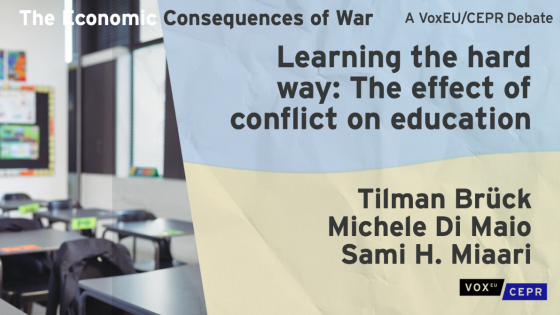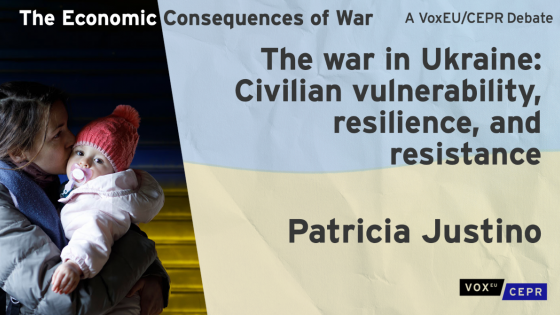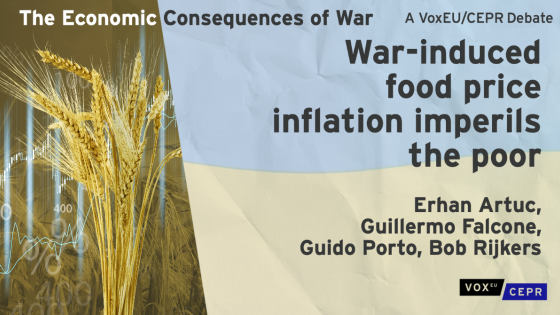Editors' note: This column is part of the Vox debate on the economic consequences of war.
The new conflict in the heart of Europe highlights the importance of understanding how conflict impacts human development. There is a relatively recent yet rapidly growing literature documenting that the economic consequences of conflict are devastating and often long-lasting (Verwimp et al. 2019, de Groot et al. 2022).1 Among the most pervasive of these effects are those affecting individual-level education outcomes for children and adolescents (UNESCO 2011).
The importance of education for economic development and individual wellbeing cannot be overemphasised, both from a historical perspective (Becker 2022) and considering its role as an engine of long-term growth (Porzio and Rossi 2022).
The existing empirical evidence indicates that the effects of violent conflict on education are highly heterogeneous. The sign and magnitude of the effects depend, among other elements, on the type of conflict (i.e. civil conflict, inter-state war, terrorism, etc.) and the type of violent events (killings, abduction, etc.), on the gender, as well as on the education outcome considered (school enrolment, attendance, attainment, etc.) (Chamarbagwala and Moran 2010, Shemyakina 2011, Leon 2012, Di Maio and Nandi 2013;, Valente 2013, Akbulut-Yuksel 2014, Justino et al. 2014, Monterio and Rocha 2017, Bertoni et al. 2019, Michaelsen and Salardi 2020, Miaari and Lee 2022).
One aspect that has received little attention so far is the effect of conflict on academic achievement for high school students and the mechanisms underlying such effects. Answering these questions is important because academic achievement is a predictor of future earnings, especially when admission to university is determined by high school final exam performance. Moreover, learning about the effects of conflict on high school students is crucial for a better understanding of the impact of violent conflict on the development prospects of an economy, given that these students will make up a large part of the country’s high-skilled workforce in the future. Finally, it particularly matters in the case of Ukraine as practically all its children attend high school and many continue to university. Hence if conflict impedes secondary school outcomes, its development impacts will be particularly relevant.
The effect of conflict on academic achievement
In our paper (Brück et al. 2019) we document the effects of violent conflict on high school education in the context of the West Bank during the Second Intifada, a period of intense violence between Israelis and Palestinians. Taking advantage of unique micro-level data, we provide the first empirical analysis of the effects of conflict on academic achievement for high school students. Specifically, we study the effect of conflict on individual results at the final high-school exam (the Tawjihi General Examination) for the population of high school Palestinian students in the West Bank during the period 2000-2005.
The West Bank, sadly, is an ideal setting to study the effect of conflict on education, and in particular on the academic achievement of high school students, for two main reasons. First, high school enrolment in the West Bank has always been high by international standards. Second, the Palestinian education system continued operating even during the Second Intifada.
Our empirical analysis proceeds in two steps. First, we estimate the effect of conflict on individual academic achievement. We use spatial and time variation in conflict intensity – as measured by the locality-level number of Palestinians killed by Israeli Defense Forces (IDF) during the academic year – to identify the effect of the Israeli–Palestinian conflict on individual exam results. By exploiting the within-school variation in the number of fatalities over time, we find that conflict reduces the probability of passing the exam, the total test score at the exam, and the probability of achieving the minimum test score needed for admission to university. We also document that the effect of conflict is not significant for students in the upper tail of the test score distribution, suggesting that the effect is more negative for less able students.
How does conflict worsen academic achievement?
The finding that conflict has a negative impact on academic achievement in high schools is hardly surprising; less obvious are the specific mechanisms through which this effect materialises. Understanding this is an important task considering that this is needed to design effective policies to mitigate the negative effect of conflict on education outcomes.
We document the existence of two distinct transmission mechanisms from violent conflict to reduced academic achievement.
As a first mechanism, we show that conflict negatively affects the quality of the learning environment at school. In particular, conflict increases overcrowding in the classroom which, in turn, correlates with a lower probability of passing the final exam.2 Interestingly, we also find that the negative effect of higher overcrowding in the classroom on the test scores is significant only for students in the lower tail of the test score distribution. This suggests that those are the students for whom the quality of the learning environment at school is likely to be more important and who will thus suffer more from the impact of the conflict-induced destruction of on school infrastructures.
The second mechanism is the worsening of students’ psychological wellbeing due to exposure to conflict-related violence. Direct exposure to conflict – as proxied by the per-capita number of fatalities occurred in the locality of the school – has a large negative impact on the student’s probability of passing the exam and this is effect is larger when the killed is young (suggesting a mechanism of self-identification). Finally, we show that the negative effect of direct exposure to conflict-related violence is largest for conflict events occurring shortly before the exam date – specifically, one month before – providing support for a psychological mechanism being at work.3
Concluding remarks
Each conflict is somehow unique. Yet, unfortunately, almost all conflicts have similar negative impacts on education.
Focusing on the period of the Second Intifada in the West Bank, our study documents that conflict events reduce Palestinian high-school students’ probability of passing the final exam, the total test score at the exam, and thus the probability of being admitted to university.
Moreover, our findings indicate that the negative effect of conflict on academic achievement may also have long-lasting consequences. By reducing the probability of a student completing high school and of being admitted to university, conflict events significantly hinder human capital accumulation and economic development. We have shown that this holds disproportionately more for lower-ability students, which may imply that conflict worsens inequality through its adverse impacts on learning and education.4 This represents a potential long-term cost to be added to the several other already documented negative consequences of conflict on education.
These negative effects are due to the conflict-induced worsening in both the quality of the school learning environment and in the psychological well-being of students. Our results thus suggest that any policy intervention to mitigate the negative effects of conflict on education outcomes should account for both of these aspects.
These findings have several implications for other countries suffering the burdens of conflict, like Ukraine in these weeks. First, the conflict-induced destruction of school infrastructure (or even the inability to maintain the existing infrastructure) may have large long-term social and economic costs. Second, it is important to acknowledge that – unfortunately – the immediate suffering caused by the fighting are only one part of the emotional burden to which individuals are exposed during a war. In fact, short-term exposure to individual violent events may have additional effects which will shape the lives and the performance of children and youth permanently. Governments of conflict-affected countries like Ukraine, their allies and donors should protect children not only from the direct effects of violent conflict but also from the indirect ones by maintaining as much as possible appropriate social infrastructures and by trying to counteract the psychological burden of experiencing violent events. These secondary prevention measures can work to alleviate some of the suffering and adverse consequences of conflict on the youngest. Even more effective would be primary prevention, of course – the prevention of war itself.
References
Akbulut-Yuksel, M (2014 “Children of War: The Long-Run Effects of Large-Scale Physical Destruction and Warfare on Children”, Journal of Human Resources 49: 634–662.
Aucejo, E, J French, P Ugalde Araya and B Zafar (2020), “COVID-19 is widening inequality in higher education”, VoxEU.org, 9 August.
Arezki, R (2022), “War in Ukraine, impact in Africa. The effect of soaring energy and food prices”, VoxEU.org, 17 March.
Artuc, E, G Falcone, G Porto and B Rijkers (2022), “War-induced food price inflation imperils the poor”, VoxEU.org, 01 April.
Becker, S O (2022), “Lessons from history for our response to Ukrainian refugees”. VoxEU.org, 29 March.
Bertoni, E, M Di Maio, V Molini and R Nisticò (2019), “Education is forbidden: The effect of the Boko Haram conflict on education in North-East Nigeria”, Journal of Development Economics 141: 102249.
Brück, T, M Di Maio and S Miaari (2019), “Learning the hard way: The effect of violent conflict on student academic achievement”, Journal of the European Economic Association 17(5): 1502–1537.
Burgess, S and H H Sievertsen (2020), “Schools, skills, and learning: The impact of COVID-19 on education”, VoxEU.org, 1 April.
Chamarbagwala, R and H Morán (2010), “The Human Capital Consequences of Civil War: Evidence from Guatemala”, Journal of Development Economics 94: 41–61.
de Groot, O J, C Bozzoli, A Alamir and T Brück (2022), “The Global Economic Burden of Violent Conflict”, Journal of Peace Research 59(2): 259-76.
Di Maio, M and T Nandi (2013), “The Effect of the Israeli-Palestinian Conflict on Child Labour and School Attendance in the West Bank”, Journal of Development Economics 100: 107–116.
Engzell, P, A Frey and M Verhagen (2020), “The collateral damage to children’s education during lockdown”, VoxEU.org, 9 November.
Fuchs-Schündeln, N, D Krueger, A Ludwig and I Popova (2020), “The long-term effects of school closures”, VoxEU.org, 12 November.
Grewenig, E, P Lergetporer, K Werner, L Woessmann and L Zierow (2020), “COVID-19 school closures hit low-achieving students particularly hard”, VoxEU.org, 15 November.
Justino, P, L Marinella, and P Salardi (2014), “Short- and Long-Term Impact of Violence on Education: The Case of Timor Leste”, World Bank Economic Review 28: 320–353.
Leon, G (2012), “Civil Conflict and Human Capital Accumulation. The Long Term Effects of Political Violence in Peru”, Journal of Human Resources 47: 991–1022.
Miaari, S and I Lee (2022), “Obstacles on the Road to School: The Impacts of Mobility Restrictions on Educational Performance”, Journal of Human Resources, forthcoming
Michaelsen, M M and P Salardi (2020), “Violence, psychological stress and educational performance during the ‘war on drugs’ in Mexico”, Journal of Development Economics 143: 102387.
Monteiro, J and R Rocha (2017), “Drug Battles and School Achievement: Evidence from Rio de Janeiro’s Favelas”, Review of Economics and Statistics 99: 213–228.
Porzio, T and F Rossi (2022), “From farms to offices: Measuring the role of human capital for structural transformation”, VoxEU.org, 28 March.
Shemyakina, O (2011), “The Effect of Armed Conflict on Accumulation of Schooling: Results from Tajikistan”, Journal of Development Economics 95: 186–200.
UNESCO (2011), The Hidden Crisis: Armed Conflict and Education, EFA Global Monitoring Report.
Vaitilingam, R (2022), “Economic consequences of Russia’s invasion of Ukraine: Views of leading economists”, VoxEU.org, 10 March.
Valente, C (2013), “Education and Civil Conflict in Nepal”, World Bank Economic Review 28: 254–383.
Verwimp, P, P Justino, and TilTman Brück (2019), “The Microeconomics of Violent Conflict”, Journal of Development Economics 141: 102297.
Endnotes
1 For preliminary analyses and estimates of the direct and indirect effects of the war in Ukraine, see Arezki (2022) and Vaitilingam (2022).
2 There are two main reasons for the conflict-induced increase in classroom overcrowding. First, military attacks and school occupations by Israel Defense Forces damaged and – in some cases – destroyed premises and properties of Palestinian schools resulting in a shortage of classrooms. Second, the conflict situation made it more difficult for the Palestinian authorities to expand the number of classroom to meet the growing number of school-aged Palestinians.
3 We also consider other mechanisms. We find that conflict intensity is associated with more school closures and more student and teacher absenteeism. Yet, due to severe data limitations on these variables, we cautiously interpret the overall empirical evidence on these mechanisms as being inconclusive
4 The findings are in line with those on effects of the COVID-19 pandemic on education. The pandemic-induced negative shocks to the supply of education has been shown to be likely to reduce the economic opportunities of youths in the long term (Engzell et al. 2020, Fuchs-Schündeln et al. 2020). These effects are expected to be particularly negative for low-achieving students with a disadvantaged socio-economic background (Aucejo et al. 2020, Burgess and Sievertsen 2020, Grewenig et al. 2020).






